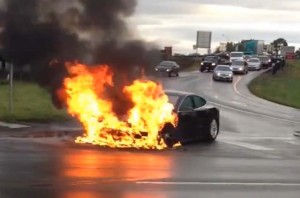
A video on YouTube showed the fire that consumed the front end of a Model S, apparently after roadway debris damaged the battery pack.
Roadway debris is tentatively catching the blame for a fire that seriously damaged a Tesla Model S being driven in a Seattle suburb – with that news, combined with new concerns about the battery-carmaker’s high-flying stock sending the price of shares plunging by more than 6%.
The fire itself raised serious concerns about the safety of not just the Tesla Model S, but about the use of lithium-ion batteries in general. There have been problems with other vehicles using the technology, while Boeing was forced to ground its new 787 Dreamliner earlier this year because of fires involving the jet’s first-of-its-king lithium battery system.
According to a report by Washington State Police, a motorist was driving a Tesla Model S equipped with the company longest-range, 85 kilowatt-hour battery. After apparently striking some metallic debris on the road, the owner began to smell smoke, police were later told, parked the vehicle and exited. The vehicle reportedly then caught fire.
Firefighters arrived within minutes but initially ran into trouble containing the blaze. They found that their attempt to extinguish the blaze with water actually intensified the fire. In fact, a warning published by Electrochem, a lithium-ion battery maker – though not a supplier to Tesla – notes lithium is a “water reactive material,” meaning it can actually catch fire or emit toxic gases when it comes into contact with water.
Emergency crews soon switched to a dry chemical extinguisher and were able to bring the blaze under control. The firefighters ultimately were on the scene for about 2-1/2 hours. The damage was largely limited to the front end of the vehicle. While it may take investigators some time to do a complete analysis of what happened, a Tesla spokesperson quickly echoed the report that the fire was caused by a metallic object hitting a module within the larger Tesla battery pack.
“This was not a spontaneous event,” spokeswoman Liz Jarvis-Shean told the Associated Press. “Every indication we have at this point is that the fire was a result of the collision and the damage sustained through that.”
(Tesla named to list of globe’s most innovative companies.Click Here for more.)
An e-mail too Tesla from TheDetroitBureau.com has not yet been answered and founder and CEO Elon Musk, known to regularly issue tweets and statements on any matter affecting his company has so far been silent about the fire.
Complicating matters, the federal government shutdown has forced U.S. safety regulators to suspend their field investigations.
(Kia readying battery-powered Soul. Click Here for more.)
The Tesla Model S mounts its batteries in the load floor in order to minimize the loss of cabin or cargo space and to improve the vehicle’s handling by lowering the center of gravity.
A video of the fire soon appeared on automotive site Jalopnik, reportedly submitted by a fan who caught the incident.
The fire raises new concerns about the volatility of lithium-ion batteries. Electrochem and other producers issue stern warnings about the challenges of manufacturing, storing and using the technology, though the battery industry also insists lithium batteries are safe when properly handled. But there have been a number of disconcerting problems in recent years.
That includes the Mideast crash of a cargo plane blamed on a battery fire, several incidents involving the lithium-ion batteries used on the Boeing Dreamliner, and some vehicle fires. A number of Fisker Karma plug-ins caught fire during Hurricane Sandy flooding in 2012 when their battery compartments became submerged.
A fire also occurred with a Chevrolet Volt weeks after being crash-tested by the Nation Highway Traffic Safety Administration. And though investigators later blamed faulty test procedures, GM made extensive modifications to further protect the Volt’s battery pack.
(Cadillac plans to “tackle” Tesla, says GM CEO Akerson. Click Hereto find out how.)
The latest lithium-ion vehicle fire might itself have spurred investor concerns but the news coincided with another event that has shaken investor confidence in a stock that has soared by more than 400% since the beginning of the year, setting one record after another as it approached $200 a share and gave Tesla a market valuation approaching that of some of the world’s larger conventional automotive companies.
The stock initially fell by 6.2%, and at least some of that plunge was blamed on a report by R.W. Baird analyst Ben Kallo downgrading Tesla shares from “Outperform” to “Neutral,” due to what he called “significant milestones” facing the company. The Model S fire does not appear to have been a factor in his review, but Kallo noted the need to boost production of the Model S, the challenges of launching Tesla’s second product line, the Model X SUV, and the ongoing roll-out of the company’s fast-charging Supercharger network.
“We believe solid execution on both of these fronts is already priced into the stock, and any hiccups in execution present stock price risk in the near to immediate term,” Kallo wrote.
Kallo isn’t the first analyst to cool on Tesla’s overheating stock. A report by Goldman Sachs earlier this year warned it was even then potentially over-priced. But after a brief pause, the company quickly regained its momentum in the market.
Whether the fire and downgrade will have more than a short-term cooling effect remains to be seen. But a critical question is whether the battery blaze will scare off potential Tesla Model S buyers.

We already know that lithium -ion batteries are a safety hazard and that there have been many fires associated with them. This incident should be another wake-up call that if you’re going to use these batteries they need to be properly manufactured, installed, maintained and properly protected. That may mean ballistic type of protection if a simple piece of metal in the road can puncture the battery module…